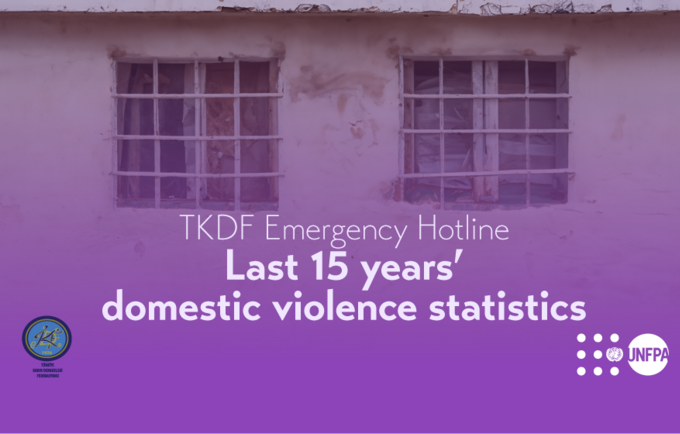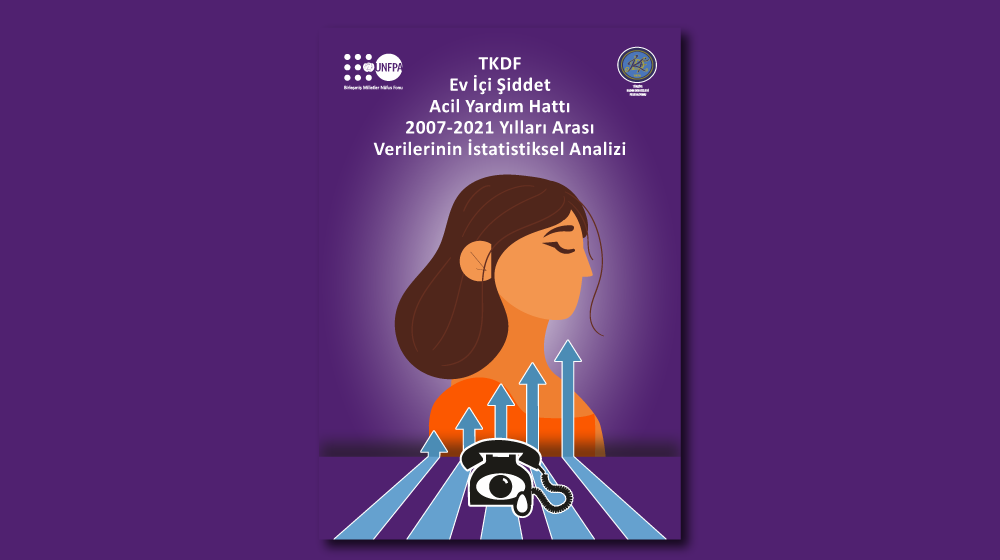8 in 10 people who are subjected to violence are women, 73 percent are married and mostly between the ages of 31-55. 90 percent of the perpetrators of violence are men, the highest percentage is “spouses” (63%), followed by “family members” (21%). These striking data were from the 'Statistical Analysis Report of Domestic Violence Emergency Hotline Data for the Years 2007-2021,' prepared with the technical and financial support of the United Nations Population Fund (UNFPA) Türkiye. The report resulted from the analysis of over 28,000 calls received by the 'Domestic Violence Emergency Hotline' which is operated by the Turkish Women's Associations Federation (TKDF) and provides services 24/7.
June 21, 2023, Ankara, Türkiye - Turkish Women's Associations Federation (TKDF) United Nations Population Fund (UNFPA) Türkiye, provided one of the most comprehensive data analyses ever conducted in Türkiye in the struggle against "Violence Against Women" which remains one of Türkiye's most important social problems. More than 28,000 calls received between 2007 and 2021 by the TKDF's "Domestic Violence Emergency Hotline," which provides services in 5 languages, were analyzed and the statistical analysis resulted in the preparation of the "Statistical Analysis Report of Domestic Violence Emergency Hotline Data for the Years 2007-2021" which contains striking statistics.
According to the report between 2007-2021, 28 thousand 198 calls were made to the “Domestic Violence Emergency Hotline”. More than 900 people called the hotline more than once. Most calls were made in 2020 when the pandemic started and lockdowns were implemented. More than half (57%) of calls were made by those who were directly subjected to violence. This was followed by "family members" with 16 percent, and "friends" and "neighbors" followed the rest. Out of every 100 people who called, 2 were the actual perpetrators of violence. The majority of them called to find out the whereabouts of the person they had been violent towards, there were also those who asked for psychological support.
According to the statistics of the calls, 8 in 10 people who are subjected to violence are women. Violence against both women and children was reported in one out of every 10 calls. Among those who are subjected to violence, 73 percent are married, 12 percent are single, and 7 percent are divorced. People who are subjected to violence are mostly between the ages of 31-55 (42%). This was followed by the 19-30 age group (37%). The data obtained from the calls reflect that the rate of violence among children increased from 7 percent to 17 percent after 2012 and to 18 percent with the pandemic.
According to the analysis of the calls received to the “Domestic Violence Emergency Hotline”; 90 percent of the perpetrators are men. The rate of cases where women and men both perpetrators is 3%. Based on the calls received, the highest percentage of violence perpetrators are 'spouses' (63%), followed by 'family members’ (21%). In cases where the perpetrator is a 'family member', out of every 10 perpetrators, 3 are the father (29%), 2 are other family members (19%), and 2 are siblings (16%). 38% of the perpetrators belong to the middle age group (31-55 years), while 34% are young people (19-30 years).
According to calls, the most common violence types are physical (17601), emotional (15059), social (5608), economic (4346), and sexual (1456). 79 percent of people who are subjected to physical violence are women and the perpetrators are mostly 'spouses' (68%). According to calls, 8 percent of violence cases are sexual violence. 73 percent of people who are subjected to sexual violence are women, 11 percent are women and children together, and 10 percent are girls.
The majority of the calls were made to get information. The most requested information was related to shelter homes. Callers mostly requested police intervention, this request was followed by requests to access shelter homes accompanied by law enforcement, and request to notify the General Directorate of Social Services and Child Services. As a result of the calls, referrals were mostly made to the judiciary (lawyers/prosecutors/forensic medicine) and law enforcement authorities.
The press launch of the report was hosted by UNFPA Türkiye Representative Hassan Mohtashami and President of TKDF Canan Güllü with the participants from the public, and private sector, embassies, international institutions, civil society, and academy at Ankara Hilton Hotel on Wednesday, 21 June.
In his speech, the UNFPA Türkiye Representative stated that gender-based violence continues to be one of the most widespread human rights violations in the world, endangering the health, safety, bodily autonomy, and future of women and girls. Emphasizing that ending violence against women and all forms of harmful practices against women and girls is one of UNFPA's three transformative goals by 2030, Mohtashami said, “We will continue to work in cooperation with the public, civil society, private sector, and academia to empower women and combat violence against women and girls.”
The President of TKDF stated that they believe the report will be an important resource for everyone working for gender equality, providing services, and advocating for equality. Güllü, mentioned the aim of this study is to raise public awareness, conduct evidence-based advocacy work, and contribute to the formulation of concrete policies. She further emphasized, 'We believe that our report will serve as a fundamental resource benefiting various groups, particularly policymakers, human rights defenders, activists, academics, students, media professionals, and representatives from the private sector, enabling the development of early intervention strategies to prevent violence in Türkiye.
HIGHLIGHTS FROM THE REPORT:
Incoming Calls:
- Between 2007-2021, 28 thousand 198 calls are made to the “Domestic Violence Emergency Hotline”
- More than 900 people called the hotline more than once.
- Most calls were made in 2020, when the pandemic started and lockdowns were implemented.
- More than half (57%) of calls were made by those who were directly subjected to violence. This was followed by "family members" with 16 percent. The rest of the callers wre "friends" and "neighbors”.
- Following words were recorded at some calls to the hotline that report violence; 'custom', 'honor', 'incest', 'child abuse', 'trauma', and 'suicide'.
- Out of every 100 people who called, 2 were the actual perpetrators of violence. While most of them called to find out the location of the person hey had been violent towards, there were also those who asked for psychological support.
Profile of people who were subjected to violence:
- According to the incoming calls, 8 in 10 people who are subjected to violence are women.
- Violence against both women and children was reported in one out of every 10 calls.
- Among those who are subjected to violence, 73% are married, 12% are single, and 7% are divorced.
- People who are subjected to violence are mostly between the ages of 31-55 (42%). This number was followed by the 19-30 age group (37%), while the least calls were received from the group above 55 years of age.
- According to the data obtained from the calls, the rate of violence against children increased from 7 percent to 17 percent in ten years, and to 18 percent during the pandemic.
Profile of perpetrators:
- 90% of the perpetrators who commit violence are men.
- According to the calls received, the perpetrator are mostly 'spouses' (63%), then family members (21%). In cases where the perpetrator is a 'family member'; out of every 10 perpetrators, 3 of them are the father (29%), 2 of them are other family members(19%), and 2 of them are siblings (16%).
- According to the analysis of calls related to child abuse and harmful practices against children, in more than half of the cases the perpetrator is family.
- 38% of the perpetrators belong to the middle age group (31-55 years), while 34% are young people (19-30 years).
- While partner violence was the most common during the pandemic, there was an increase in neighbor, employer, and ex-boyfriend violence after the pandemic.
Most Reported Types of Violence:
- According to calls, the most common forms of violence are physical (17601), emotional (15059), social (5608), economic (4346), and sexual (1456).
- 79 percent of people who are subjected to sexual violence are women and the perpetrators are mostly spouses (68%)
- 95 percent exposed of those subjected to economic violence, 76 percent of those subjected to emotional violence, and 55 percent of those subjected to social violence are also women.
- 8 percent of the violence cases are sexual violence. Of the ones who are subjected to sexual violence; 73 percent women, 11 percent women and children, 10 percent girls.
- Only half of the calls for sexual violence cases were made by the ones who were subjected to violence themselves.
Requests and Referrals:
- The majority of the calls were made to ask for information. The most frequently asked information was about shelters. This was followed by requests for general information on violence against women, the operation of the emergency hotline and psychological support.
- Callers mostly requested police intervention, this was followed by transfer to a shelter or social services support accompanied by law enforcement authorities, and seeking notice to the General Directorate of Social Services and Child Services.
- As a result of the calls, referrals were mostly made to the judiciary (lawyers/prosecutors/forensic medicine) and law enforcement authorities. It follows the referrals to Violence Prevention and Monitoring Centers (ŞÖNİM), shelters, solidarity institutions (Gelincik hattı, KAMER, Mor Çatı etc.), financial aid institutions, local authorities.


